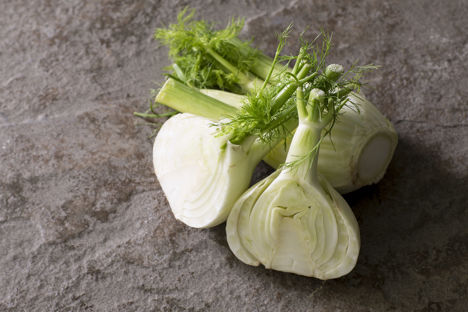When referenced in recipes, 'fennel' can refer to the green-white fennel bulb, the celery-like fennel stalk, and also dried fennel seeds. Though they all have different applications, all parts of the plant share distinctive aniseed flavours.
Fresh fennel has a long season from June through to October. It's round this time of year that the stalks are at their crunchiest, the white bulbs are plump and juicy, and the leaves are at their most delicate and feathery. Because of their summer season, fennel is often associated with sunny, Mediterranean recipes. The dried seeds are available year-round, and are most often used to flavour sausages or cured meats, as well as being a staple spice in Indian dishes, and used as part of a pan masala, post-meal mouth freshener.
Fennel has strong anise flavours, with a distinct bitterness, and lemony citric sharpness. Despite such big flavours, fennel rarely overwhelms dishes. Perhaps as a result of its clean, fresh bite which cuts through rich food. This makes it a very versatile ingredient. As nineteenth century French writer, Alexandre Dumas observed: "It's not unusual to see working people with a bunch of fennel under the arm making their lunch or dinner of this, accompanied by bread." Dumas was not the only notable person to discuss fennel - American Founding Father, Thomas Jefferson gushed: "There is no vegetable which equals its flavour...I prefer it to every other vegetable, or to any fruit."
As is the way with most liquorice-flavoured ingredients, fennel has a long tradition as a medicinal plant. It is said to strengthen the immune system, lower blood pressure, aid digestion and even cure flatulence when drank as a tea.
How to cook with fennel
The crunch of sliced fennel bulb, or fennel stalk means that it's often served raw - introducing a radish, or celery-like texture to salads or coleslaw. The fennel is usually cut very thinly, often with a mandolin, or even shaved over dishes as a crisp garnish.
When the bulb or stalks are sautéed, braised or roasted, the flavour begins to change and the sharpness turns to sweetness. Roast fennel stalks develop a caramel-like sweetness, and recipes where the bulb is pan-friedalso mean that the clean white flesh turns golden, and the flavours mellow and become more rounded.
Fennel bulbs can also be boiled or steamed. This curbs the bitterness, without introducing any sweet-caramel notes. Boiling or steaming fennel softens the bulb, meaning that it can be broken down into a purée.
What goes with fennel
The big anise flavours mean that fennel is a great vegetable for cutting through rich or fatty food, like pork orduck. Perhaps fennel's closest partner though is fish and shellfish. The sharp, almost lemony fresh flavours makes it the perfect pairing - from flavouring a classic Bouillabaisse, to garnishing a Scallop and tuna ceviche.
Think warm, Mediterranean flavours when cooking with fennel - like tomatoes, red onion and peppers. Even try experimenting by using fennel in a sweet context, harnessing roasted caramel-sweetness, or raw lemony freshness as Adam Simmonds does with this fennel granita.
Get in touch
Please sign in or register to send a comment to Great British Chefs.



